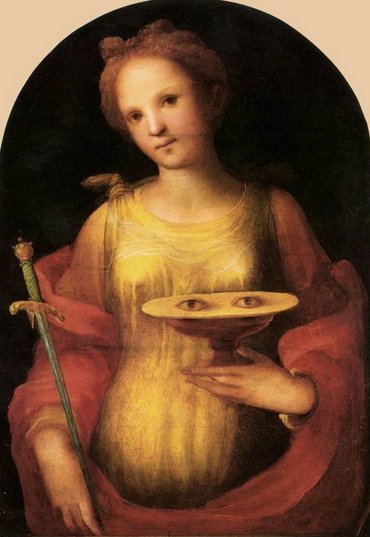Both Apus and Triangulum Australe are fairly new creations in contrast to the ancient Ara which we ought to return to: "... the flame was conceived of as rising northwards through the Milky Way, or that the latter itself was the smoke and flame; and it was so thought of and represented by the ancients, and down to the times of Arabic globes and Middle Age manuscripts. But from Bayer's day to ours it has been shown in an inverted position, which for a southern constellation is appropriate." (Allen)
The arrangement with a pair of hanau glyphs creates a kind of 'door frame' for heliacal Heka (λ Orionis) in the center, which is where it should be because I have put the date Mrigashīrsha 1 (ruled by Heka) at June 12. In G there is a similar 'door frame' with heliacal λ Eridani in its center. The day number of June 6 is half 314:
Perhaps St Lucia (December 13) once was connected with looking at Ara, the Scorpion's curved tail, and the Milky Way, close to the Full Moon in the night. Lucia ('Light') sacrificed her eyes and maybe there had to be darkness (λ) before fire could return.
... Al Maisān, the title of γ Geminorum, by some error of Firuzabadi was applied to this star [λ Orionis] as Meissa, and is now common for it. Al Sufi called it Al Tahāyī; but Al Ferghani and Al Tizini knew it as Rās al Jauzah, the Head of the Jauzah, which it marks. The original Arabic name, Al Hak'ah, a White Spot, was from the added faint light of the smaller φ¹and φ² in the background, and has descended to us as Heka and Hika. These three stars were another of the Athāfiyy [tripods used for cooking] of the Arabs; and everywhere in early astrology were thought, like all similar groups, to be of unfortunate influence in human affairs. They constituted the Euphratean lunar station Mas-tab-ba-tur-tur, the Little Twins, a title also found for γ and η Geminorum; and individually were important stars among the Babylonians, rising to them with the sun at the summer solstice, and, with α and γ, were known as Kakkab Sar, the Constellation of the King ... |










